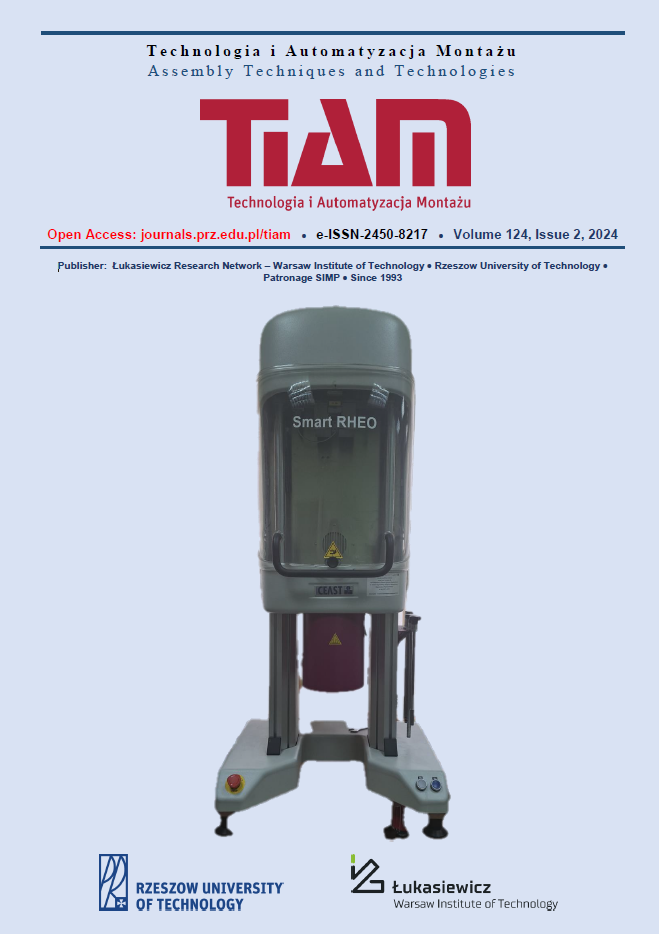Abstract
Rapid development of Artificial Intelligence (AI) technologies in recent years has created new opportunities to address the growing challenges in the aviation industry. Machine learning and Deep Learning, particularly through Convolutional Neural Networks (CNNs), have advanced image recognition capabilities, enhancing inspection processes possibilities. This paper explores the integration of AI with drones to improve the precision, efficiency, and speed of inspections of airframe emphasizing the necessity of accurate equipment preparation and precise operational planning. The study demonstrates how AI algorithms can process high-resolution images and sensor data to identify and classify defects. The motivation for this paper is to address the critical need for more efficient inspection methods in aviation, driven by the industry's increasing demand for higher repair process throughput and stringent safety standards.
References
Amosov, O. S., Amosova, S. G., & Iochkov, I. O. (2022). Deep Neural Network Recognition of Rivet Joint Defects in Aircraft Products. Sen-sors, 22(3417). doi:http://doi.org/10.3390/s22093417
Andreopoulos, A., & Tsotsos, J. K. (2013). 50 Years of object recognition: Directions for-ward. Computer Vision and Image Under-standing, 827-891. doi:http://doi.org/10.1016/j.cviu.2013.04.005
Bagheri, M., Akbarib, A., & Mirbagheri, S. A. (2019). Advanced control of membrane foul-ing in filtration systems usingartificial intelli-gence and machine learning techniques:A criti-cal review. Process Safety and Environmental Protection, 123, 229-252. doi:https://doi.org/10.1016/j.psep.2019.01.01
Brandoli, B., Geus, A. R., Souza, J. R., Spadon, G., Soares, A., Jose F. Rodrigues, J., . . . Matwin, S. (2021). Aircraft Fuselage Corro-sion Detection Using Artificial Intelligence. Sensors, 21.
Copeland, B. J., & Proudfoot, D. (2007). Artificial intelligence: History, foundations, and philo-sophical issues. Philosophy of psychology and cognitive science, 429-482. doi:https://doi.org/10.1016/B978-044451540-7/50032-3
Deng, J., Dong, W., Socher, R., Li, L.-J., Li, K., & Fei-Fei, L. (2009). ImageNet: A Large-Scale Hierarchical Image Database. 2009 IEEE Computer Society Conference on Computer Vision and Pattern Recognition, (pp. 248-255). Miami. doi:http://doi.org/10.1109/CVPR.2009.5206848
Future of Aviation. https://www.icao.int/Meetings/FutureOfAviation/Pages/default.aspx (access: 10.06.2024)
Garbuno, D. M. The Global Impact Of The Pratt & Whitney Engine Issues. https://simpleflying.com/global-impact-pratt-whitney-engine-issues/ (access: 10.06.2024)
GROWTH AND FORECAST 2024 – 2043. https://www.grupooneair.com/analysis-global-growth-commercial-aviation/ (access: 10.06.2024)
Hinton, G. E., Osindero, S., & Teh, Y.-W. (2006). A Fast Learning Algorithm for Deep Belief Nets. Neural Computation, 18, 1527-1554.
Javidi, B. (2002). Image Recognition and Classifi-cation: Algorithms, Systems, and Applica-tions. New York: Marcel Dekker.
Kaartinen, E., Dunphy, K., & Sadhu, A. (2022). LiDAR-Based Structural Health Monitoring: Applications in Civil Infrastructure Systems. Sensors 2022, 22. doi:https://doi.org/10.3390/s22124610
Kaushikkumar, P. (2024). Ethical Reflections on Data-Centric AI: Balancing Benefits and Risks. International Journal of Artificial In-telligence Research and Development, 2(1), 1-17.
Kuittinen, M. (2024). Exploring the Effects of Artificial Intelligence Capabilities on Firm Performance. Kuopio: University of Eastern Finland, Faculty of Social Sciences and Busi-ness, Department of Business .
LeCun, Y., Bottou, L., Bengio, Y., & Haffne, P. (1998). Gradient-Based Learning Applied to Document Recognition. Proceedings of the IEEE, 2278-2324. doi:https://doi.org/10.1109/5.726791
Long, J., Shelhamer, E., & Darrell, T. (2015). Fully Convolutional Networks for Semantic Segmentation. 2015 IEEE Conference on Computer Vision and Pattern Recognition, (pp. 3431-3440). Boston. doi:http://doi.org/10.1109/CVPR.2015.7298965
Milson, S., & Bruce, A. (2024). The Intelligent Data Era: How AI is Shaping the Future of Big Data. EasyChair Preprint no. 11896.
National Transport Safety Board. (2024). Aviation Investigation Preliminary Report - Accident Number: DCA24MA063.
Nex, F., & Remondino, F. (2014). UAV for 3D mapping applications: A review. Applied Ge-omatics, 6. doi:http://doi.org/10.1007/s12518-013-0120-x
Pargieła, K. (2023). Optimising UAV Data Acqui-sition and Processing for Photogrammetry: A Review. GEOMATICS AND ENVIRONMEN-TAL ENGINEERING, 17(3), pp. 29-59. doi:https://doi.org/10.7494/geom.2023.17.3.29
Sun, H., Yan, H., Hassanalian, M., Zhang, J., & Abdelkef, A. (2023). UAV Platforms for Data Acquisition and Intervention Practices in For-estry: Towards More Intelligent Applications. Aerospace. doi:https://doi.org/10.3390/aerospace10030317
Yao, H., Qin, R., & Chen, X. (2019). Unmanned Aerial Vehicle for Remote Sensing Applica-tions—A Review. Remote Sens, 11. doi:https://doi.org/10.3390/rs11121443
Zachariah, R. A., Sharma, S., & Kumar, V. (2023). Systematic review of passenger de-mand forecasting in aviation industry. Multi-media Tools and Applications, 1-37. doi:https://doi.org/10.1007/s11042-023-15552-1
Zhao, H., Xi, J., Zheng, K., Shi, Z., Lin, J., Nik-bin, K., . . . Wang, B. (2020). A review on solid riveting techniques in aircraft assem-bling. Manufacturing Review, 7(40).
Zuchniak, K., Dzwiniel, W., Majerz, E., Pasternak, A., & Dragan, K. (2021). Corrosion detection on aircraft fuselage with multi-teacher knowledge distillation. Computational Sci-ence – ICCS 2021.
Zwęgliński, T. (2020). The Use of Drones in Disas-ter Aerial Needs Reconnaissance and Damage Assessment—Three-Dimensional Modeling and Orthophoto Map Study. Sustainability, 12. doi:http://doi.org/10.3390/su12156080

